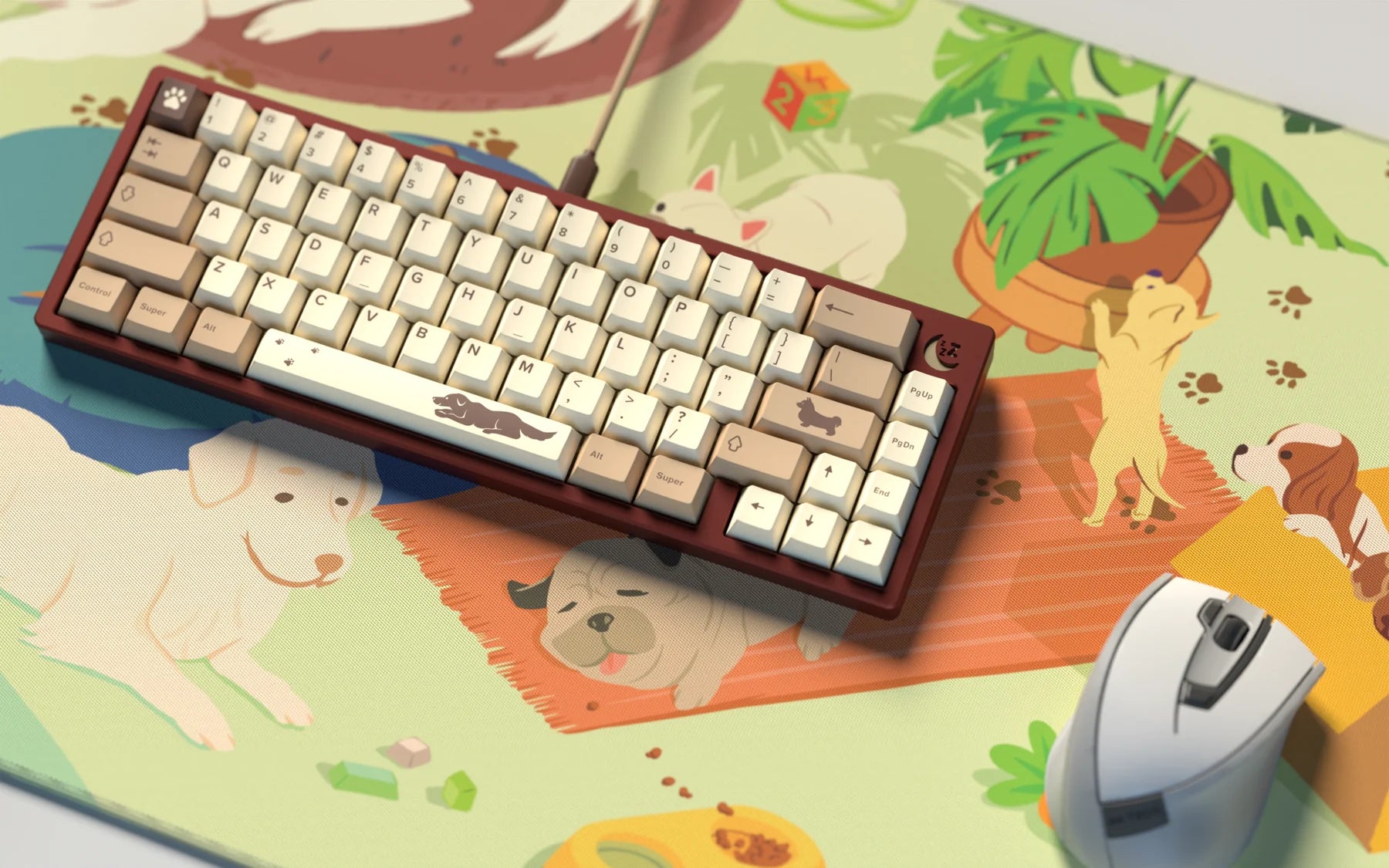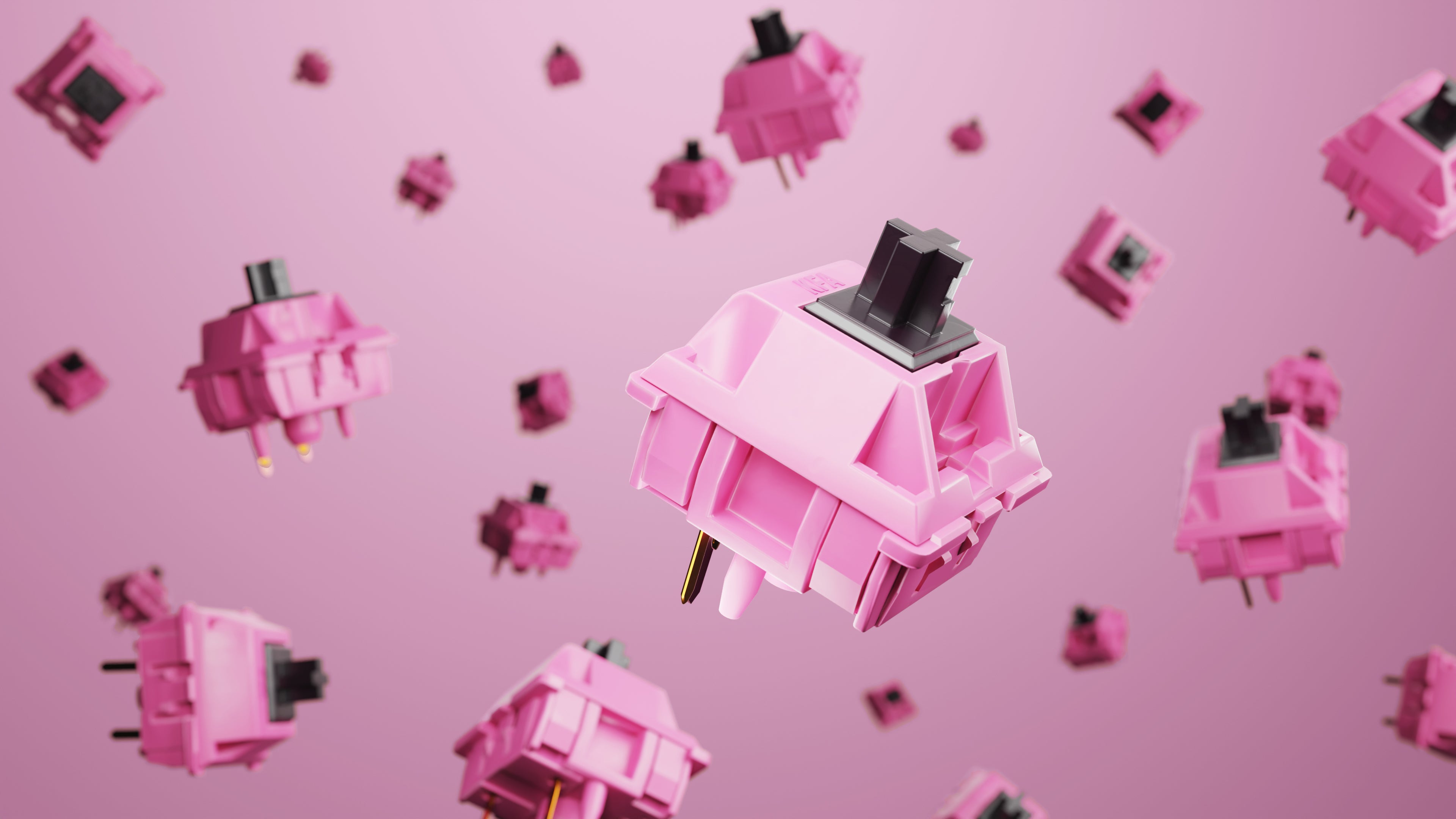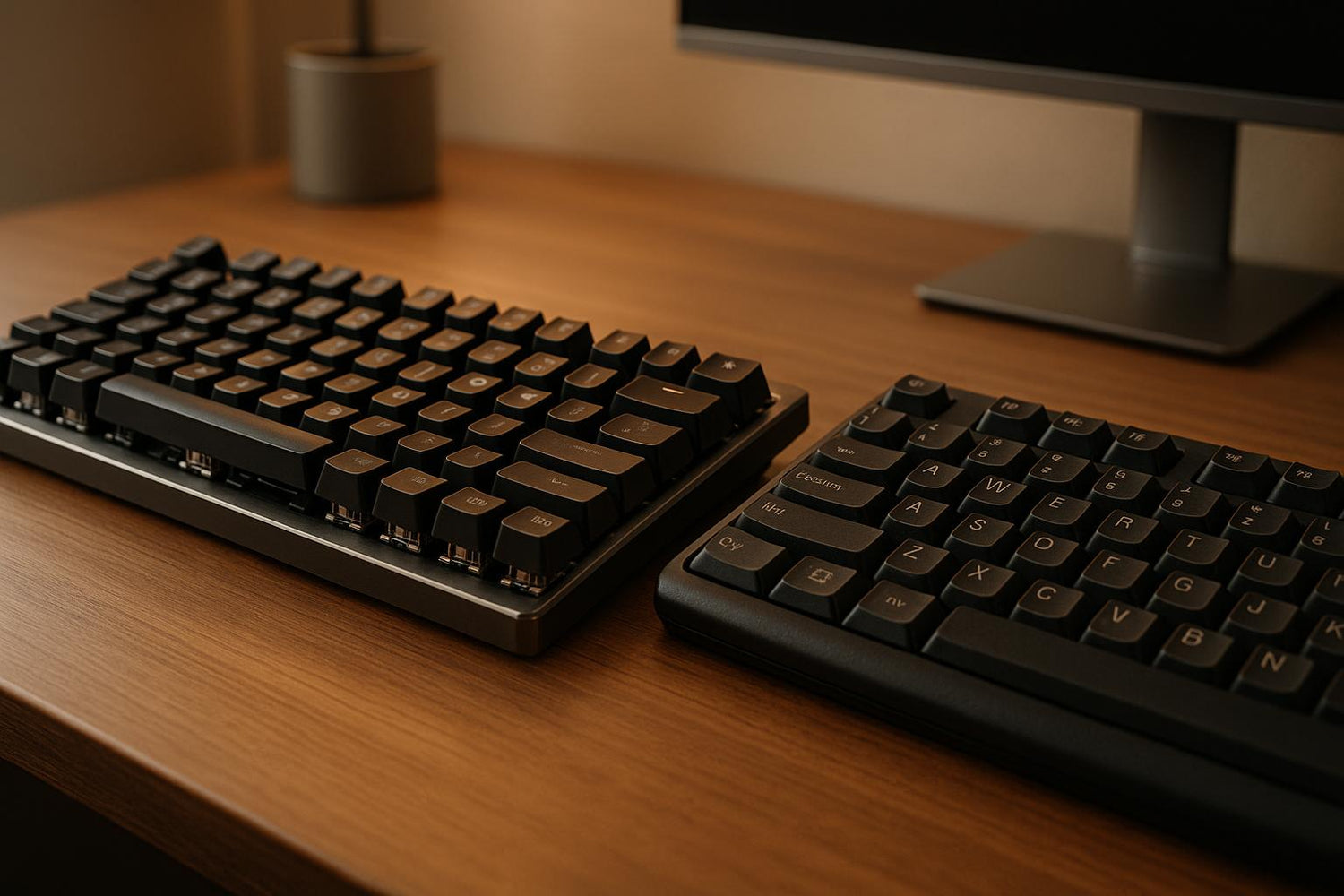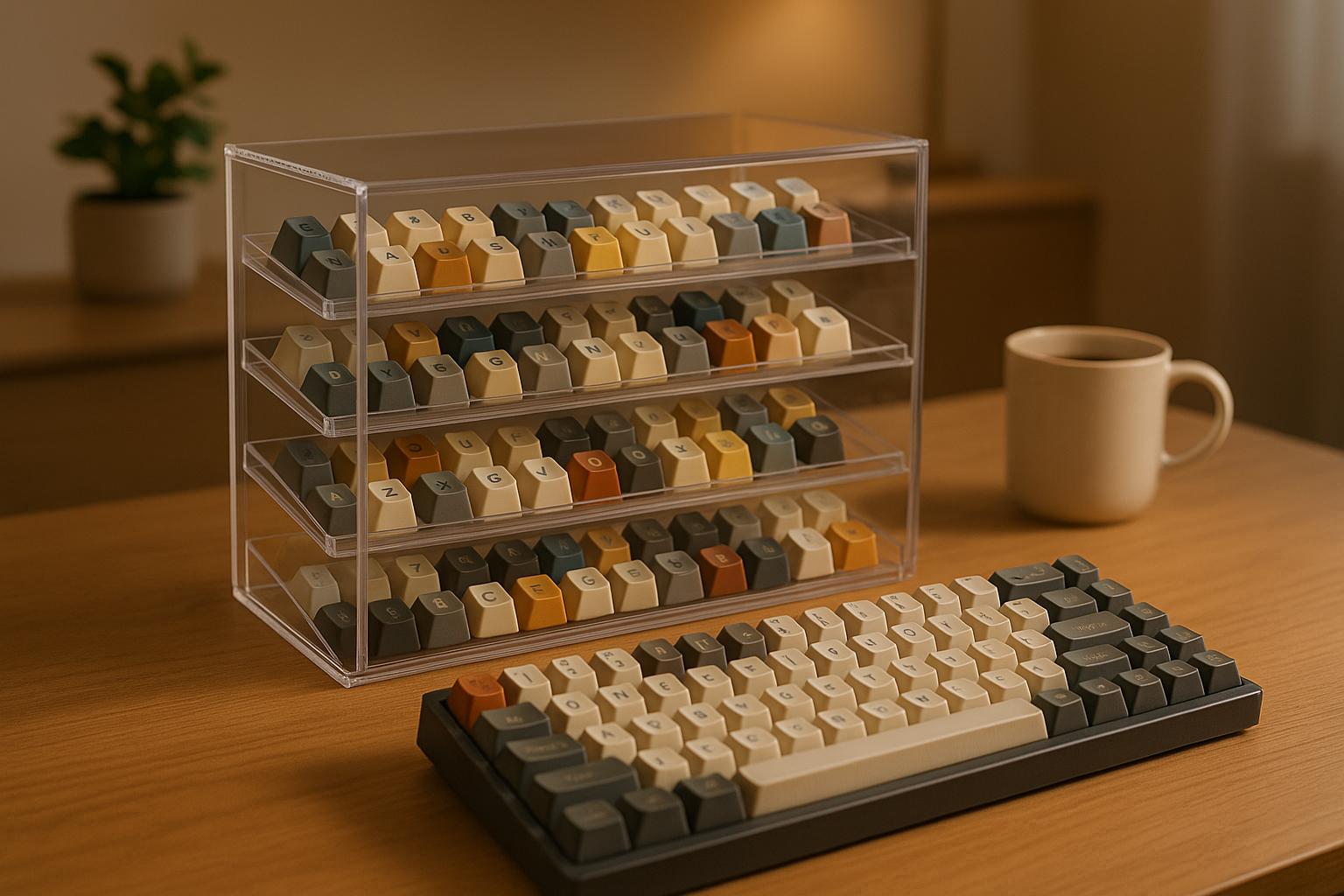Mechanical keyboards last 10–15 years, while standard keyboards often need replacing in 1–5 years. The difference lies in their construction:
- Mechanical keyboards: Built with individual switches rated for 50–100 million keystrokes, durable materials like aluminum or PBT keycaps, and repairable parts. Designed for heavy use, they resist wear, spills, and dust.
- Standard keyboards: Use a single rubber membrane rated for ~5 million keystrokes. They're less durable, prone to wear, and often need full replacement when damaged.
Quick Comparison
| Feature | Mechanical Keyboards | Standard Keyboards |
|---|---|---|
| Lifespan | 10–15 years | 1–5 years |
| Keystroke Lifespan | 50–100 million | ~5 million |
| Key Mechanism | Individual switches (repairable) | Single rubber membrane |
| Keycap Material | PBT or high-quality ABS | Basic ABS |
| Spill/Dust Resistance | High | Low |
| Repairability | Replaceable parts | Full keyboard replacement |
Mechanical keyboards cost more initially but save money long-term due to their durability and repairability. If you type or game heavily, they’re the better choice.
Membrane vs Mechanical vs Optical Keyboards | Everything You Need To Know!
Materials and Construction
The durability of a keyboard largely depends on the materials used and how it's constructed. Mechanical keyboards are known to last anywhere from 10 to 15 years with proper care, while membrane keyboards often need replacing after just a few years.
Mechanical Keyboards
Mechanical keyboards are built to handle heavy, consistent use. High-quality models feature frames made from aluminum or steel, which provide excellent stability and protect the internal components from damage. Even when plastic is used for the casing, manufacturers rely on premium materials like ABS, PBT, or polycarbonate. Among these, PBT stands out for its resistance to wear and its ability to maintain texture over time, making it a favorite for durability.
One of the defining features of mechanical keyboards is the individual switches under each key. Trusted brands like Cherry produce switches rated for 50–100 million keystrokes, and these switches are often user-replaceable, significantly extending the keyboard's lifespan. Each switch is a self-contained unit, consisting of a spring, electrical contacts, and a protective housing.
High-end mechanical keyboards often include additional design elements, such as sound-dampening foam layers and gasket-mounted structures. These features not only enhance the typing experience by reducing noise but also minimize stress on the keyboard frame, preventing direct contact between metal components. This combination of durable materials and replaceable parts ensures mechanical keyboards can deliver consistent performance for years.
Standard Keyboards
In contrast, standard membrane keyboards prioritize affordability over longevity. Their lightweight, thin plastic housings are more prone to flexing under pressure and can crack if dropped. These keyboards rely on a single rubber or silicone membrane to register keystrokes. Over time, the constant compression of this dome-style membrane reduces its responsiveness. Since the system is integrated, failing components cannot be replaced individually, meaning the entire keyboard often needs to be discarded.
The keycaps on membrane keyboards are usually made from basic ABS plastic, which wears down faster and develops a shiny, polished look with extended use.
Here's a quick comparison of the materials and construction differences:
| Material Type | Mechanical Keyboards | Standard Keyboards |
|---|---|---|
| Frame/Case | Aluminum, steel, or premium plastics (ABS, PBT, Polycarbonate) | Lightweight, thin plastic housing |
| Key Mechanism | Individual mechanical switches (replaceable, 50–100 million keystrokes) | Single rubber/silicone membrane (~5 million keystrokes) |
| Keycaps | Durable PBT or high-quality ABS plastic | Basic ABS plastic prone to wear |
| Repairability | Replaceable individual components | Entire keyboard must be replaced |
The differences in materials and construction highlight why mechanical keyboards tend to outlast standard models. Up next, we’ll take a closer look at lifespan and how switch quality factors into durability.
Lifespan and Switch Longevity
When it comes to keyboard durability, the difference between mechanical and membrane switches is striking, especially in terms of how long they last and how well they perform over time.
Mechanical Switches
Mechanical switches are built to last. Most are rated for 30–70 million keystrokes, with premium options like Cherry MX switches reaching up to 100 million keystrokes. This impressive lifespan is thanks to their high-quality construction, which includes a sturdy housing, responsive springs, and gold-plated contacts. These components ensure consistent performance, even after years of heavy use.
Unlike membrane keyboards, which can lose their responsiveness as their rubber components wear out, mechanical switches maintain their tactile feedback and actuation force throughout their lifetime. This reliability makes them a favorite among gamers, writers, and professionals who demand precision and durability.
Membrane Switches
Membrane keyboards, on the other hand, have a much shorter lifespan. Their switches are typically rated for 5–10 million keystrokes, and they’re more vulnerable to environmental factors like heat, humidity, and dust, which can speed up their wear and tear.
The design of membrane keyboards relies on a thin rubber or silicone dome beneath each key. Over time, this material loses elasticity, leading to a decline in responsiveness. Since the membrane layer is a single integrated sheet, damage in one spot can impact multiple keys or even the entire keyboard.
| Usage Level | Mechanical Keyboards | Membrane Keyboards |
|---|---|---|
| Light Use | 18–20 years | 10–20 years |
| Moderate Use | 14–16 years | 5–10 years |
| Heavy Use | 10–15 years | 1–5 years |
For heavy users - like gamers, programmers, or writers - mechanical keyboards clearly outshine their membrane counterparts. While a mechanical keyboard can often perform reliably for over a decade, a membrane keyboard may need replacing after just a few years.
This durability also translates into long-term cost savings. While mechanical keyboards often come with a higher price tag upfront, their extended lifespan makes them more economical in the long run, particularly for those who rely on their keyboards daily. Up next, we’ll look at how these lifespan differences tie into keycap durability and resistance to wear.
sbb-itb-3cb9615
Resistance to Wear and Tear
Durability isn’t just about how long a keyboard lasts - it’s also about how well it holds up to constant use and everyday challenges. Mechanical and standard keyboards differ significantly in their ability to maintain both appearance and function over time.
Keycap Longevity
Keycaps bear the brunt of daily use, and the materials used in mechanical keyboards set them apart. Most mechanical keyboards feature PBT (Polybutylene Terephthalate) keycaps, known for their durability and ability to maintain a textured, matte finish. These keycaps resist the shiny, greasy look that often develops with heavy use.
On the other hand, standard keyboards generally use ABS keycaps. While ABS is more common, it’s less durable. Over time, ABS keycaps tend to develop a glossy, sticky surface as they collect oils from your fingers. Additionally, the legends (letters and symbols) on ABS keycaps are more prone to fading, especially on frequently used keys. In contrast, PBT keycaps can endure years of use while keeping their finish and clear legends intact.
"PBT (Polybutylene Terephthalate) keycaps offer several benefits, including exceptional durability, resistance to wear and shine, and excellent keycap texture that provides a comfortable typing experience, making it the most sought material for typists and gamers." – Hirosart
| Keycap Factor | Mechanical (PBT) | Standard (ABS) |
|---|---|---|
| Surface Texture | Maintains a matte finish | Becomes shiny and greasy |
| Legend Durability | Resistant to fading | Prone to fading and wear |
| Oil Resistance | High resistance | Low resistance |
Next, let’s explore how design impacts resistance to environmental hazards.
Environmental Resistance
Mechanical keyboards are better equipped to handle dust, spills, and other environmental challenges, thanks to their thoughtful design and construction.
"Mechanical keyboards are resistant to debris and spills because the keyswitch mechanism is protected, sealed, or can otherwise be easily cleaned." – Nelson Miller Group
Features like sealed switches and drainage holes help prevent liquids from spreading across the entire keyboard. In the event of a spill, damage is often localized, making cleanup and repairs manageable.
Standard keyboards, however, rely on a single rubber membrane that’s far more vulnerable. Liquids can seep into the membrane, affecting multiple keys or even rendering the entire keyboard unusable. The membrane’s sponge-like nature makes thorough cleaning difficult and often ineffective.
"Membrane keyboards are typically less durable than their mechanical counterparts, with their lifespan rated at only 10 million keystrokes." – Nelson Miller Group
Dust is another factor where mechanical keyboards shine. Their modular design allows users to clean or replace individual switches if needed. With standard keyboards, dust often gets trapped within the membrane, leading to sticky or unresponsive keys - a problem that’s much harder to resolve.
For anyone working in environments prone to spills, dust, or other accidents, the repair-friendly nature of mechanical keyboards is a major advantage. Instead of replacing the entire keyboard, you can simply swap out a damaged switch.
In short, the combination of durable materials, smarter design, and ease of maintenance makes mechanical keyboards far more resilient against the wear and tear of everyday life, even in tougher conditions.
Durability Comparison Table
Take a closer look at how mechanical and membrane keyboards stack up in terms of durability.
Comparison Metrics
Here's a breakdown of the key factors that influence long-term durability:
| Durability Factor | Mechanical Keyboards | Standard Keyboards |
|---|---|---|
| Switch Lifespan | 50–100+ million keystrokes | ~5 million keystrokes |
| Average Keyboard Life | 5–15 years with proper maintenance | 1–2 years on average |
| Switch Construction | Individual mechanical switches with metal contacts | Rubber dome and membrane layer |
| Keycap Material | High-quality ABS or PBT plastics | Basic plastic keycaps |
| Frame Construction | Metal backplate with reinforced housing | Integrated plastic membrane design |
| Spill Resistance | Often spill-resistant with sealed switches | Highly susceptible to liquid damage |
| Dust Protection | Individual switches can be cleaned or replaced | Membrane design traps dust, hard to clean |
| Repairability | Individual components are replaceable | Full keyboard replacement is typical |
| Fade Resistance | PBT keycaps resist fading and shine | Legends fade over time with use |
Mechanical keyboards clearly outshine their membrane counterparts in durability. For instance, Cherry MX switches are rated for a staggering 100 million keystrokes, while membrane keyboards typically max out at just 5 million. Gateron switches, another popular option, handle at least 50 million keystrokes, and premium models like Topre electrostatic switches can exceed 100 million presses.
These numbers are backed by the overall build quality. Mechanical keyboards are designed for longevity, often lasting 10–15 years with proper care, thanks to their precision-engineered switches. In contrast, membrane keyboards rely on less durable rubber domes and thin layers that wear out much faster.
Another standout feature of mechanical keyboards is their modular design. If a key or switch fails, you can replace the individual part, extending the keyboard's lifespan. On the other hand, membrane keyboards offer little flexibility - if one component breaks, you’ll likely need to replace the entire unit.
For those who type extensively or game daily, the durability differences are hard to ignore. While mechanical keyboards may cost more upfront, their sturdy construction and repairability make them a smarter long-term investment. These factors highlight their value for anyone seeking a reliable, long-lasting keyboard.
Conclusion
When it comes to durability, mechanical keyboards clearly outshine their membrane counterparts. From the longevity of their switches to their overall build quality, mechanical keyboards consistently come out on top.
Mechanical keyboards boast lifespans of 10 to 15 years, far surpassing the 1 to 5 years typical of membrane keyboards. This extended lifespan is supported by designs that emphasize easy maintenance and repair. Thanks to their modular construction, individual components can be replaced without needing to discard the entire keyboard. This not only reduces long-term costs but also aligns with environmentally conscious practices.
Another key advantage lies in the materials used. Mechanical keyboards often feature premium components like PBT keycaps that resist wear and shine, as well as sturdy metal backplates that provide a level of durability plastic-based membrane keyboards simply can't match. Whether you're a coder or a gamer, these features ensure your keyboard can handle the demands of daily use.
Investing in a mechanical keyboard also brings financial benefits over time. For instance, KeebsForAll offers the Freebird TKL Full Kit, featuring a durable aluminum case and a hot-swappable design, starting at $249.99. This kit is designed for long-term reliability, allowing users to easily replace switches as needed. The store also provides essential maintenance items, such as Krytox 205 g0 lubricant starting at $7.95 and durable stabilizers, ensuring your keyboard stays in peak condition for years to come.
FAQs
Why are mechanical keyboards more durable than standard keyboards?
Mechanical keyboards stand out for their durability, thanks to their durable materials and sturdy construction. Unlike standard keyboards that rely on rubber domes, mechanical keyboards use switches with metal contacts. These switches are designed to handle tens of millions of keystrokes, making them far more resilient over time.
Another advantage is how easy they are to repair or modify. You can replace individual switches, keycaps, or other parts without tossing the entire keyboard. This not only extends their lifespan but also makes them a great option for avid typists, gamers, or anyone who prioritizes long-lasting performance.
What makes mechanical keyboards more durable than standard keyboards?
Mechanical keyboards stand out for their durability, thanks to the use of high-quality materials and solid construction. Many models come with double-shot injection-molded keycaps, which are resistant to fading and wear over time. The keycaps are often made from tough plastics like PBT or ABS, ensuring they hold up well under regular use. The cases, on the other hand, are crafted from materials such as aluminum, polycarbonate, or even wood, providing both strength against physical damage and a premium tactile experience.
What really sets mechanical keyboards apart is the longevity of their switches. These switches are built to endure tens of millions of keystrokes - far outlasting the lifespan of most standard keyboards. Whether you're a casual typist or a professional who spends hours at the keyboard, their resilience against heavy use and environmental wear makes them a smart, long-term choice.
Are mechanical keyboards more cost-effective than standard keyboards in the long run?
Mechanical keyboards might seem pricey at first - typically costing between $80 and $200, compared to the $20 to $50 range for standard membrane keyboards. But their durability and build quality make them worth the investment. These keyboards are designed with high-quality switches and sturdy materials, allowing them to handle tens of millions of keystrokes and last an impressive 5 to 15 years or more. In contrast, membrane keyboards generally wear out after just 1 to 3 years.
What sets mechanical keyboards apart is their longevity and repair-friendly design. With regular maintenance, they can outlast their cheaper counterparts by a wide margin. Plus, their customizable and repairable nature means you can replace parts or make upgrades, adding even more value over time.



![[Pre-Order] Autumn Leaves PBT Keycaps - KeebsForAll](http://keebsforall.com/cdn/shop/products/DSC09732.jpg?v=1676148273)






Leave a comment
This site is protected by hCaptcha and the hCaptcha Privacy Policy and Terms of Service apply.